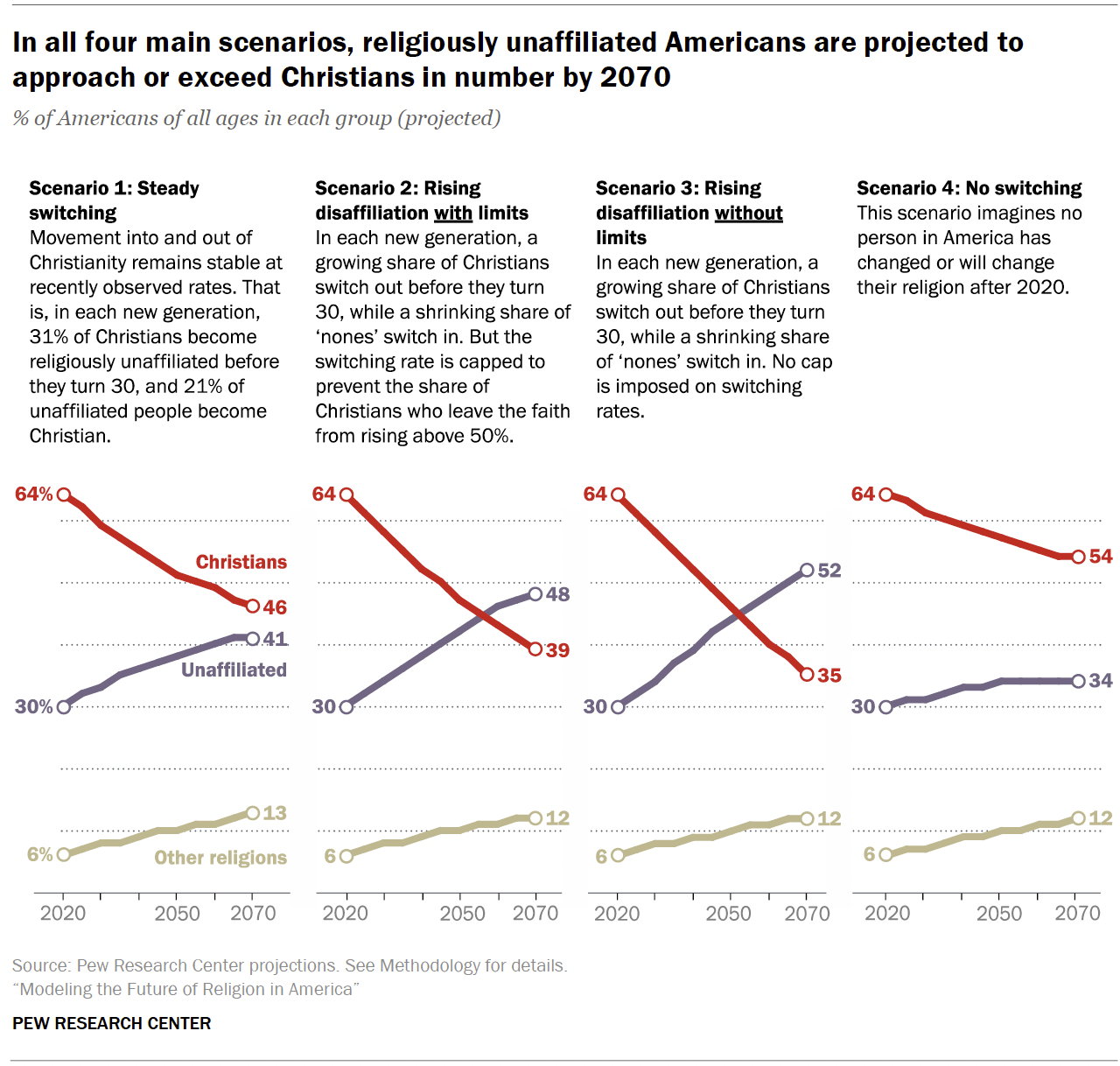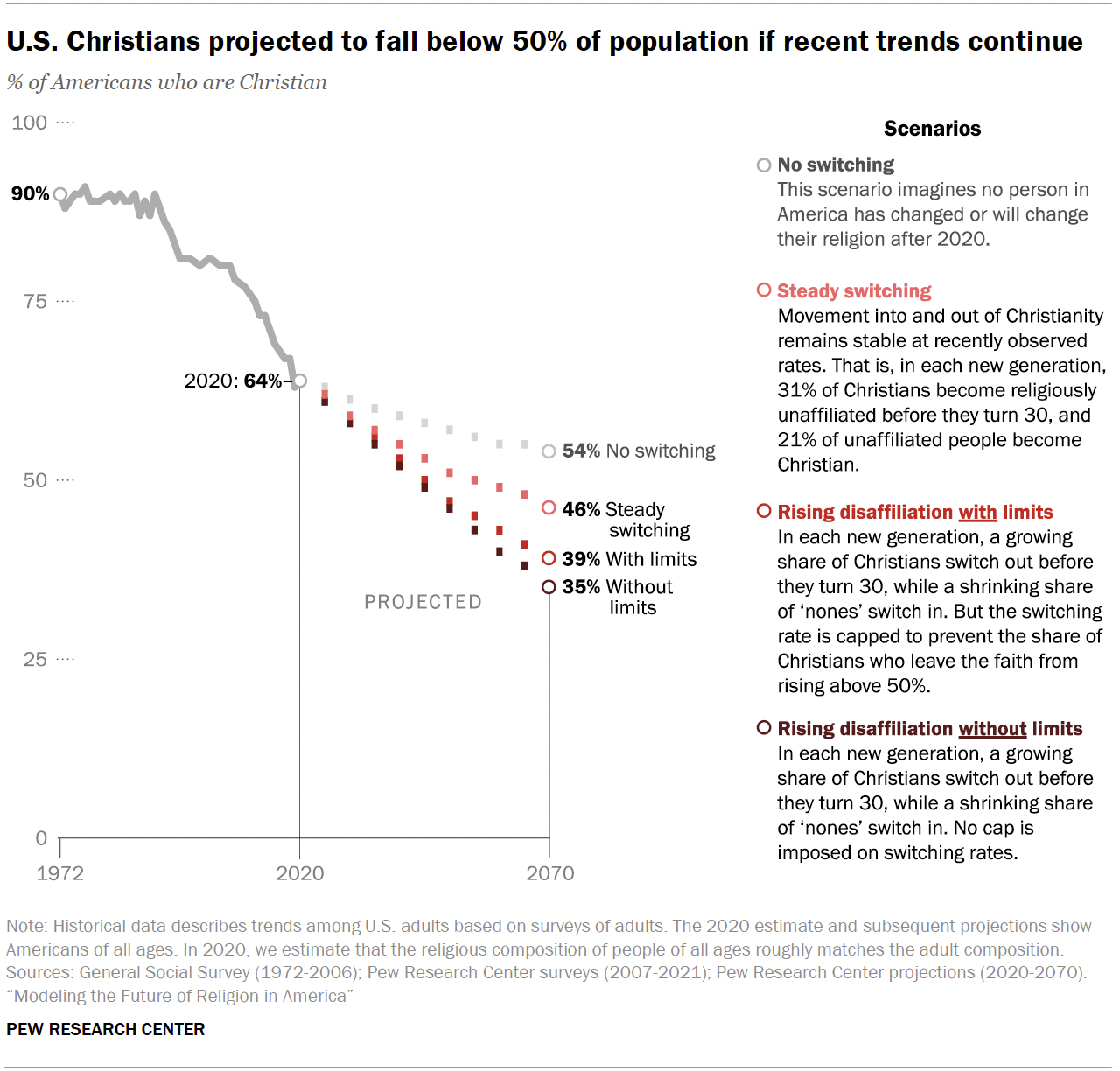US will no longer have Christian majority by 2070, study reveals
In all scenarios projected by the study, the number of people who identifed as religiously unaffiliated grew in America in the decades to come
Your support helps us to tell the story
From reproductive rights to climate change to Big Tech, The Independent is on the ground when the story is developing. Whether it's investigating the financials of Elon Musk's pro-Trump PAC or producing our latest documentary, 'The A Word', which shines a light on the American women fighting for reproductive rights, we know how important it is to parse out the facts from the messaging.
At such a critical moment in US history, we need reporters on the ground. Your donation allows us to keep sending journalists to speak to both sides of the story.
The Independent is trusted by Americans across the entire political spectrum. And unlike many other quality news outlets, we choose not to lock Americans out of our reporting and analysis with paywalls. We believe quality journalism should be available to everyone, paid for by those who can afford it.
Your support makes all the difference.The United States remains home to more Christians than any other country in the world. By 2070, those demographics could see a shift and the religion that has long been the country’s majority denomination could become a minority, according to a new study.
“If recent trends in religious switching continue, Christians could make up less than half of the U.S. population within a few decades,” to as little as a third, modellers from the Pew Research Center wrote in a new study released Tuesday.
The projections, which used the country’s current religious composition as the jumping off point, were made by considering religious differences by age and sex, birth rates, migration patterns and rates of “religious switching”.
“Switching, which in some cases could be described as religious conversion, is defined in this report as a change between the religion in which a person was raised (in childhood) and their present religious identity (in adulthood),” the report defines the term as.
The report projects four possible landscapes in the US, all with varying rates of religious switching, which has steadily been speeding up since the 1990s. In all four projections, the religiously unaffiliated, otherwise referred to as the “nones”, increased.

Based on current patterns observed in recent decades, modellers note that about a third of Christians will switch out of their religion between the ages of 15 to 29, a time that is described as being a “tumultuous period in which religious switching is concentrated”.
Given those same trends observed, they note that about 21 per cent of nones – or young people who are unaffiliated with a religious denomination – will switch into Christianity. If these trends remain stable, which the researchers note is unlikely given that religious switching has only picked up in recent years, then Christians would make up 46 per cent of the US population by 2070, while nones would comprise 41 percent.
If religious switching continues to grow, but is capped at 50 per cent, then Christians would represent a little more than a third (39 per cent) of the country’s population by 2070. Americans identifying as nones would represent nearly half the country (48 per cent).
Without caps placed on religious switching, the study found that the gap between the religious nones and Christians could increase to reflect nearly a complete role reversal of today’s current trends, with Christians representing 35 per cent of the population (currently 64 per cent) and nones making up a majority with 52 per cent (currently 30 per cent).

The centre emphasised throughout the report that all the projections were based on data and mathematical models and should not be taken as predictions for the future.
“None of these hypothetical scenarios is certain to unfold exactly as modeled, but collectively they demonstrate how much impact switching could have on the overall population’s religious composition within a few decades,” they write.
Factors that they note could significantly influence the religious composition of the country and perhaps even trigger a Christian revival in the coming decades include economic depression, climate crisis, changing immigration patterns or religious innovations.
These factors, however, were not included in the study.
Under all four scenarios, researchers note that adherents of non-Christian religions (e.g., Jews, Muslims, Hindus and Buddhists), would grow to represent 12 to 13 per cent of the population, doubling their current share.
This is likely because the growth of non-Christian faiths in the US doesn’t hinge on religious switching, but rather factors like migration. In the study, they kept migration patterns constant across all four scenarios.
The prospective decline in Christian identity falls in line with trends occurring throughout Western Europe over the past 50 years, the study notes. For instance, they point to trends observed in places like Great Britain, where “nones” surpassed Christians in 2009, and the Netherlands where this kind of disaffiliation began taking off in the 1970s.
Disaffiliation in identity, they note, is again just that in the study: “[we] do not project how religious beliefs and practices might change in the coming decades.”
The distinction is an important one, as they also found that Americans who identify as “nones” are not uniformly nonbelieving or nonpracticing. Many in that group continue to observe traditional religious practices, “including a solid majority who believe in some kind of higher power or spiritual force”.
Funding for this study came from The Pew Charitable Trusts and the John Templeton Foundation.




Join our commenting forum
Join thought-provoking conversations, follow other Independent readers and see their replies
Comments